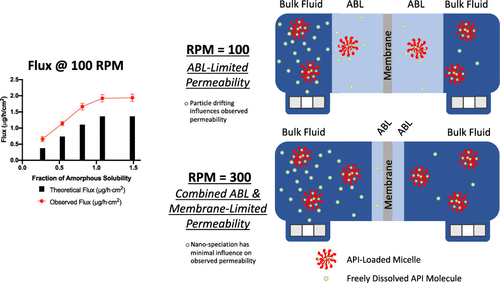当前位置:
X-MOL 学术
›
Mol. Pharmaceutics
›
论文详情
Our official English website, www.x-mol.net, welcomes your
feedback! (Note: you will need to create a separate account there.)
Towards Developing Discriminating Dissolution Methods for Formulations Containing Nano-Particulates in Solution; The Impact of Particle Drift and Drug Activity in Solution.
Molecular Pharmaceutics ( IF 4.5 ) Pub Date : 2020-09-23 , DOI: 10.1021/acs.molpharmaceut.0c00599 Freddy A Arce 1 , Nico Setiawan 2 , Heather R Campbell 1 , Xingyu Lu 3, 4 , Matthew J Nethercott 5 , Paul Bummer 1 , Yongchao Su 3, 6, 7 , Patrick J Marsac 1
Molecular Pharmaceutics ( IF 4.5 ) Pub Date : 2020-09-23 , DOI: 10.1021/acs.molpharmaceut.0c00599 Freddy A Arce 1 , Nico Setiawan 2 , Heather R Campbell 1 , Xingyu Lu 3, 4 , Matthew J Nethercott 5 , Paul Bummer 1 , Yongchao Su 3, 6, 7 , Patrick J Marsac 1
Affiliation

|
Enabling formulations are an attractive approach to increase the dissolution rate, solubility, and oral bioavailability of poorly soluble compounds. With the growing prevalence of poorly soluble drug compounds in the pharmaceutical pipeline, supersaturating drug delivery systems (SDDS), a subset of enabling formulations, have grown in popularity due to their properties allowing for drug concentrations greater than the corresponding crystalline solubility. However, the extent of supersaturation generated as the enabling formulation traverses the gastrointestinal (GI) tract is dynamic and poorly understood. The dynamic nature of supersaturation is a result of several competing kinetic processes such as dissolution, solubilization by formulation and endogenous surfactants, crystallization, and absorption. Ultimately, the free drug concentration, which is equivalent to the drug’s inherent thermodynamic activity amid these kinetic processes, defines the true driving force for drug absorption. However, in cases where solubilizing agents are present (i.e., surfactants and bile salts), drug molecules may associate with colloidal nanoscale species, complicating drug activity determination. These nanoscale species can drift into the aqueous boundary layer (ABL), increasing the local API activity at the membrane surface, resulting in increased bioavailability. Herein, a novel approach was developed to accurately measure thermodynamic drug activity in complex media containing drug distributed in nanoparticulate species. This approach captures the influence of the ABL on the observed flux and, ultimately, the predicted unbound drug concentration. The results demonstrate that this approach can help to (1) measure the true extent of local supersaturation in complex systems containing solubilizing excipients and (2) elucidate the mechanisms by which colloidal aggregates can modulate the drug activity in solution and potentially enhance the flux observed across a membrane. The utilization of these techniques may provide development scientists with a strategy to evaluate formulation sensitivity to nanospeciation and allow formulators to maximize the driving force for absorption in a complex environment, perhaps enabling the development of dissolution methods with greater discrimination and correlation to pre-clinical and clinical data sets.
中文翻译:

为在溶液中含有纳米颗粒的制剂开发区分溶解方法;溶液中粒子漂移和药物活性的影响。
赋能制剂是一种提高难溶性化合物的溶出度、溶解度和口服生物利用度的有吸引力的方法。随着难溶性药物化合物在制药管道中的日益流行,过饱和药物递送系统 (SDDS) 是一种可行的制剂,由于其特性允许药物浓度大于相应的结晶溶解度,因此越来越受欢迎。然而,当使能制剂穿过胃肠 (GI) 道时产生的过饱和程度是动态的并且知之甚少。过饱和的动态特性是几个相互竞争的动力学过程的结果,例如溶解、制剂和内源性表面活性剂的增溶、结晶和吸收。最终,游离药物浓度,这相当于药物在这些动力学过程中的固有热力学活性,定义了药物吸收的真正驱动力。然而,在存在增溶剂(即表面活性剂和胆汁盐)的情况下,药物分子可能与胶体纳米级物质结合,使药物活性测定复杂化。这些纳米级物质可以漂移到水性边界层 (ABL) 中,增加膜表面的局部 API 活性,从而提高生物利用度。在此,开发了一种新方法来准确测量包含分布在纳米颗粒物种中的药物的复杂介质中的热力学药物活性。这种方法捕捉 ABL 对观察到的通量的影响,并最终捕捉到预测的未结合药物浓度。结果表明,这种方法可以帮助 (1) 测量含有增溶赋形剂的复杂系统中局部过饱和的真实程度,以及 (2) 阐明胶体聚集体可以调节溶液中药物活性并可能增强观察到的通量的机制。膜。这些技术的利用可以为开发科学家提供一种策略来评估制剂对纳米形态的敏感性,并使配方设计师能够最大限度地提高在复杂环境中吸收的驱动力,也许能够开发出与临床前和临床数据集。
更新日期:2020-11-02
中文翻译:

为在溶液中含有纳米颗粒的制剂开发区分溶解方法;溶液中粒子漂移和药物活性的影响。
赋能制剂是一种提高难溶性化合物的溶出度、溶解度和口服生物利用度的有吸引力的方法。随着难溶性药物化合物在制药管道中的日益流行,过饱和药物递送系统 (SDDS) 是一种可行的制剂,由于其特性允许药物浓度大于相应的结晶溶解度,因此越来越受欢迎。然而,当使能制剂穿过胃肠 (GI) 道时产生的过饱和程度是动态的并且知之甚少。过饱和的动态特性是几个相互竞争的动力学过程的结果,例如溶解、制剂和内源性表面活性剂的增溶、结晶和吸收。最终,游离药物浓度,这相当于药物在这些动力学过程中的固有热力学活性,定义了药物吸收的真正驱动力。然而,在存在增溶剂(即表面活性剂和胆汁盐)的情况下,药物分子可能与胶体纳米级物质结合,使药物活性测定复杂化。这些纳米级物质可以漂移到水性边界层 (ABL) 中,增加膜表面的局部 API 活性,从而提高生物利用度。在此,开发了一种新方法来准确测量包含分布在纳米颗粒物种中的药物的复杂介质中的热力学药物活性。这种方法捕捉 ABL 对观察到的通量的影响,并最终捕捉到预测的未结合药物浓度。结果表明,这种方法可以帮助 (1) 测量含有增溶赋形剂的复杂系统中局部过饱和的真实程度,以及 (2) 阐明胶体聚集体可以调节溶液中药物活性并可能增强观察到的通量的机制。膜。这些技术的利用可以为开发科学家提供一种策略来评估制剂对纳米形态的敏感性,并使配方设计师能够最大限度地提高在复杂环境中吸收的驱动力,也许能够开发出与临床前和临床数据集。










































 京公网安备 11010802027423号
京公网安备 11010802027423号